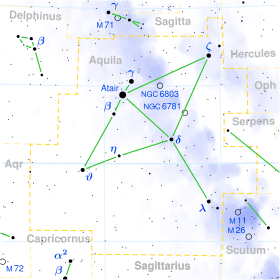Nu Aquilae

| |
| Observation data Epoch J2000 Equinox J2000 | |
|---|---|
| Constellation | Aquila |
| Right ascension | 19h 26m 31.09000s[1] |
| Declination | +00° 20′ 18.8521″[1] |
| Apparent magnitude (V) | 4.72[2] + 9.6[3] |
| Characteristics | |
| Spectral type | F3 Ib[4] + A2[3] |
| U−B color index | +0.60[2] |
| B−V color index | +0.59[2] |
| Astrometry | |
| Radial velocity (Rv) | –2.30[5] km/s |
| Proper motion (μ) | RA: +0.57[1] mas/yr Dec.: –2.31[1] mas/yr |
| Parallax (π) | 1.15 ± 0.27[1] mas |
| Distance | approx. 2,800 ly (approx. 900 pc) |
| Absolute magnitude (MV) | –5.0[4] |
| Details | |
| Mass | 10.6[4] M☉ |
| Radius | 78[4] R☉ |
| Luminosity | 11,800[4] L☉ |
| Temperature | 6,900[4] K |
| Metallicity | 7.47[4] |
| Rotational velocity (v sin i) | 13[6] km/s |
| Age | 15[4] Myr |
| Other designations | |
| A: 32 Aql, BD+00°4206, HD 182835,HIP 95585, HR 7387, SAO 124628, 2MASS J19263109+0020187 | |
| B: BD+00°4204, SAO 124623, 2MASS J19261836+0021184 | |
Nu Aquilae (ν Aql, ν Aquilae) is the Bayer designation for a double star in the constellation of Aquila and lies close to the celestial equator. It has an apparent visual magnitude of 4.72 and so is visible to the naked eye.
The spectrum of ν Aql A matches a stellar classification of F3, with the luminosity class of Ib indicating this is a supergiant. It has over twelve times the mass of the Sun and 78 times the Sun's radius. The outer atmosphere has an effective temperature of 6,900 K and it is radiating 11,800 times as much light as the Sun. At this heat, it has the yellow-white hue of an F-type star.[7] Based upon an annual parallax shift of only 1.15 mas (with a 23% margin of error), it is approximately 2,800 light-years (860 parsecs) from Earth.
ν Aql B is a tenth magnitude star 220 arc-seconds distant. Little is known about it except an approximate spectral classification[8]
References
- 1 2 3 4 5 van Leeuwen, F. (November 2007), "Validation of the new Hipparcos reduction", Astronomy and Astrophysics, 474 (2): 653–664, arXiv:0708.1752
 , Bibcode:2007A&A...474..653V, doi:10.1051/0004-6361:20078357.
, Bibcode:2007A&A...474..653V, doi:10.1051/0004-6361:20078357. - 1 2 3 Ducati, J. R. (2002). "VizieR Online Data Catalog: Catalogue of Stellar Photometry in Johnson's 11-color system". CDS/ADC Collection of Electronic Catalogues. 2237. Bibcode:2002yCat.2237....0D.
- 1 2 Roeser, S.; Bastian, U. (1988). "A new star catalogue of SAO type". Astronomy and Astrophysics Supplement Series. 74: 449. Bibcode:1988A&AS...74..449R.
- 1 2 3 4 5 6 7 8 Lyubimkov, L. S.; et al. (2010). "Accurate fundamental parameters for A-, F- and G-type Supergiants in the solar neighbourhood". Monthly Notices of the Royal Astronomical Society. 402 (2): 1369–1379. arXiv:0911.1335
 . Bibcode:2010MNRAS.402.1369L. doi:10.1111/j.1365-2966.2009.15979.x.
. Bibcode:2010MNRAS.402.1369L. doi:10.1111/j.1365-2966.2009.15979.x. - ↑ Gontcharov, G. A. (2006). "Pulkovo Compilation of Radial Velocities for 35 495 Hipparcos stars in a common system". Astronomy Letters. 32 (11): 759. Bibcode:2006AstL...32..759G. doi:10.1134/S1063773706110065.
- ↑ Bernacca, P. L.; Perinotto, M. (1970), "A catalogue of stellar rotational velocities", Contributi Osservatorio Astronomico di Padova in Asiago, 239 (1), Bibcode:1970CoAsi.239....1B.
- ↑ "The Colour of Stars", Australia Telescope, Outreach and Education, Commonwealth Scientific and Industrial Research Organisation, December 21, 2004, retrieved 2012-01-16
- ↑ Perryman, M. A. C.; Lindegren, L.; Kovalevsky, J.; Hoeg, E.; Bastian, U.; Bernacca, P. L.; Crézé, M.; Donati, F.; Grenon, M.; Grewing, M.; Van Leeuwen, F.; Van Der Marel, H.; Mignard, F.; Murray, C. A.; Le Poole, R. S.; Schrijver, H.; Turon, C.; Arenou, F.; Froeschlé, M.; Petersen, C. S. (1997). "The HIPPARCOS Catalogue". Astronomy and Astrophysics. 323. Bibcode:1997A&A...323L..49P.